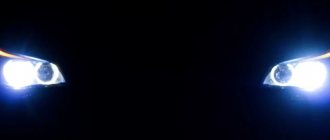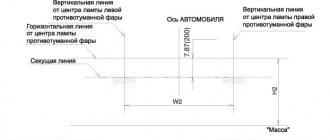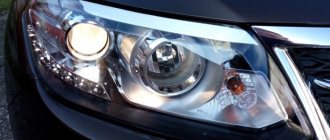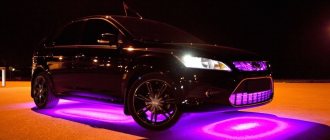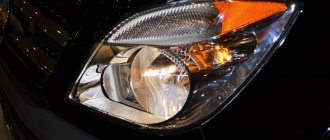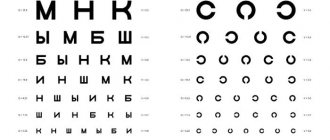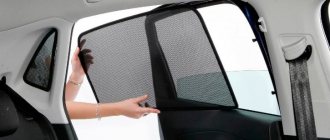Types of lamps
Before we talk about penalties for LEDs in car headlights, it is necessary to understand the difference between their different types. The following light sources are used in cars today:
- Incandescent lamps. In them, light is emitted by a spiral that heats up when an electric current passes through it. Air is evacuated from lamp bulbs to extend the life of the filament. Such lamps are the most affordable, but have a short resource and burn out quickly.
- Halogen. Incandescent lamps with the bulb filled with a buffer gas (a mixture of bromine and iodine halogens), which protects the coil from burnout. They are currently the most common source of headlights for cars.
- Xenon. Gas-discharge lamps filled with mercury and xenon vapor, in which a luminous electric arc is formed. Xenon sources produce a more bluish and brighter glow, have a high-quality reflector and good focusing.
- LED. Lamps in which radiation is emitted by a semiconductor when an electric current passes through it. They produce a stream of white radiation with a power of up to 6000 Kelvin. Today these are the brightest, most powerful and durable light sources.
Depending on the specific type of light source, headlights also differ. Thus, optics for halogen lamps are not suitable for LEDs, since they require a special lens to ensure correct focusing. If you install an LED in a headlight for halogen lamps, its glow will be too bright, with virtually no dispersion - it will hit the eyes of drivers of oncoming cars, which can ultimately lead to an accident. To make it easier to select lamps for headlights, the latter have special markings:
- C, K and CR - for incandescent lamps;
- HC, HR and HCR – for halogen;
- DR, DC and VSK - for xenon.
These types of headlights are officially permitted and reflected in regulations. There is no special marking for LED automotive optics in Russian legislation, since it is currently installed only on new imported vehicles. However, the LED lamps themselves are marked L, so it is expected that in the future this will also be used to designate headlights adapted for them.
Technical requirements for automotive light sources are reflected in the “Technical Regulations of the Customs Union”, as well as GOST 8769-75, GOST R 51709-2001 and “List of faults and conditions under which the operation of a vehicle is prohibited”. It is these documents that must be used as a guide when choosing and installing certain lamps on a vehicle.
Why is deprivation of rights for LED lamps illegal?
Everything is very simple. According to paragraph 3.1 of the Appendix to the Traffic Regulations, it is prohibited to drive a car if the type or color of the lamps is not permitted by the design of the car. Such requirements are regulated by the Technical Regulations, stating that the designation R, C or CR is for incandescent, halogen and incandescent bulbs, and DR, DC, DCR is for xenon.
But for LED lamps there is no separate marking at all. But in practice, they are equated to halogen ones by the designation of the headlights themselves, intended for use with such bulbs.
Let's say you installed LEDs in your headlights, although the headlights are designed for use only with conventional incandescent lamps. In this case, you are indeed violating paragraph 3.1 of the Traffic Regulations Appendix, because the type of lamps does not match the headlights.
And deprivation of rights for LED lamps is illegal for one simple reason - there is no article in the Code of Administrative Offenses providing for deprivation of the right to drive for this violation. According to the law, the prosecution must be under Article 12.5, Part 1 of the Code of Administrative Offenses, which provides for violation of the basic provisions for admission, and the fine under this part is 500 rubles, or even a warning (written):
1. Driving a vehicle in the presence of malfunctions or conditions under which, in accordance with the Basic Provisions for the admission of vehicles to operation and the duties of officials to ensure road safety, operation of the vehicle is prohibited, with the exception of malfunctions and conditions specified in parts 2 - 7 of this article, entails a warning or the imposition of an administrative fine in the amount of 500 rubles.
When is it legal to use LED lamps?
There are several situations in which the use of LED lamps is not illegal:
- the vehicle is initially produced by the manufacturer with LED headlights - this applies to some foreign cars of the latest generation (Audi, Lexus, Ford, etc.);
- this car model and the corresponding headlights are no longer produced - that is, it is not possible to replace the optics;
- In this vehicle model, the manufacturer has provided the opportunity to replace the installed headlights with LED ones (in this case, the manufacturer itself installs LED optics on cars of this series, but released later).
In other cases, the unauthorized replacement by the owner of the car of “original” lamps with LED lamps is considered contrary to the law and is subject to administrative penalties.
Why is deprivation for LED lamps in dimensions illegal?
They are most often deprived of it under Part 3 of Article 12.5 of the Administrative Code. But it provides for punishment for non-compliance with the operating mode and color of the headlights established by the Basic Provisions of the Traffic Regulations. The latter only regulate the color of the headlights and say that it should be yellow, white or orange. Very rarely, LEDs in dimensions give off a blue color; most often the color is white.
But even if the color of the side lights does not match, the deprivation is illegal, since, in addition to the color, the operating mode must also be violated. Moreover, the Basic Regulations for 2021 do not indicate the operating mode. But there is an indirect explanation in the Technical Regulations, according to which such a mode can be either constant or flashing.
Thus, if the dimensions blink, then the headlights are in flashing mode. This, by the way, happens when the LED lamp is faulty, but rarely.
Nevertheless,
It’s just because the LED lamps themselves are too big, and you can’t put them there.
What is the penalty for using LED lamps?
The liability of the car owner for the unauthorized installation of LED lamps is regulated by clause 3 of Art. 12.5 Code of Administrative Offences. In accordance with it, the following types of punishment are provided:
- Fine in the amount of 500 rubles;
- Deprivation of the right to drive a vehicle for a period of 6-12 months;
- Confiscation of LED lamps.
Practice shows that until mid-2021, the main punishment for this offense was deprivation of a driver’s license. However, from June 25, 2021, the resolution of the Plenum of the Supreme Court of the Russian Federation No. 20 changed the procedure for imposing sanctions, and now mainly a fine is issued for the installation of LED lamps. This is due to the fact that the requirements state that the basis for deprivation of a driver’s license is violation of the specified color of lights and operating mode. At the same time, most LEDs emit in the same spectrum as halogens - the difference can only be determined with the help of special equipment, which is not available at every traffic police station. In addition, deprivation of rights for LED lamps is carried out only through the court - this complicates the procedure and often traffic police inspectors prefer not to complicate their lives, limiting themselves only to a fine.
Legalization of LED lamps for cars
You can avoid being fined for LED headlights and use them freely by taking the following measures:
- purchase certified optics provided by the car model and allowing the installation of LED lamps;
- install optics with LED lamps in the car;
- write an application to the State Traffic Safety Inspectorate at the place where the vehicle is registered to change the design of the vehicle;
- undergo a vehicle inspection with the appropriate note in its diagnostic card;
- obtain a certificate of vehicle compliance with road traffic regulations.
If the automaker currently produces cars of your model with pre-installed LED optics, then you can also install LED lamps on your vehicle. Such changes will be considered to comply with the characteristics stated in the technical documentation and no punishment will follow.
Grounds for imposing a fine
A fine for LED lamps can be received if the requirements of articles of PP No. 109, which directly prohibit the operation of vehicles, are violated:
- if the main parameters, the number of lighting devices and their location do not correspond to the technical specifications, with the exception of models whose production has been discontinued (3.1);
- requirements for headlight adjustment (3.2) were violated;
- non-standard lenses or lamps of a type not provided for in the electrical power supply circuit of the machine (3.4) are installed.
Administrative measures may be taken against drivers who have not complied with the requirements of PP No. 109, which clarified paragraph 3.6 on restrictions on the use of lights with the following characteristics:
- White devices are prohibited in the front and rear, including fog devices;
- yellow and orange shades are not allowed for use in front;
- Red, yellow and orange colors cannot be used on the luggage compartment side.
Violation of any of these requirements determines the possibility of receiving a fine for diode bulbs in headlights or other lighting fixtures of a car, the sanctions and amount of which are provided for in Part 3 of Article 12.5 of the Code of Administrative Offenses:
- 500 rubles with confiscation of equipment if committed for the first time;
- Repeated or malicious violation is punishable by deprivation of a driver’s license for diode lamps for a period of six months to a year.
It is important to know! Even without special equipment, an employee can easily identify the installed LED lamps in the PTF and a fine, like for other violations, cannot be avoided.
So do LED bulbs work in regular headlights? Opinion of specialists from the magazine “Behind the Wheel”
In order not to resort to the opinion of only one foreign expert, we will present the arguments of domestic experts from the magazine “Behind the Wheel”. In an extremely revealing and very interesting review article-experiment “LEDs instead of halogens in standard headlights: a complete failure!” experts described the test results of five LED models.
The experiment consisted of several tests. We will briefly describe them and the results (read more about the test on “Behind the Wheel” by clicking on the link above).
1. Regloskop (a device familiar to everyone after undergoing maintenance) - checks the light distribution: three out of five LED lamps failed the test;
2. The second, final practical test was carried out to determine compliance with the requirements of UNECE Regulation No. 112–00 regarding low beam. That is, according to GOST or the National Standard of the Russian Federation, which prescribes uniformity for the operation of automobile headlights. The result surprised even seasoned testers: ALL THE LAMPS FAILED THE TEST! Even the most expensive ones.
“All the LED light sources, one by one placed by the testing laboratory staff in the GAZelle headlight, blinded the oncoming driver, and the cheapest ones, in addition, refused to properly illuminate the right side of the road,” write experts from the automobile magazine.
